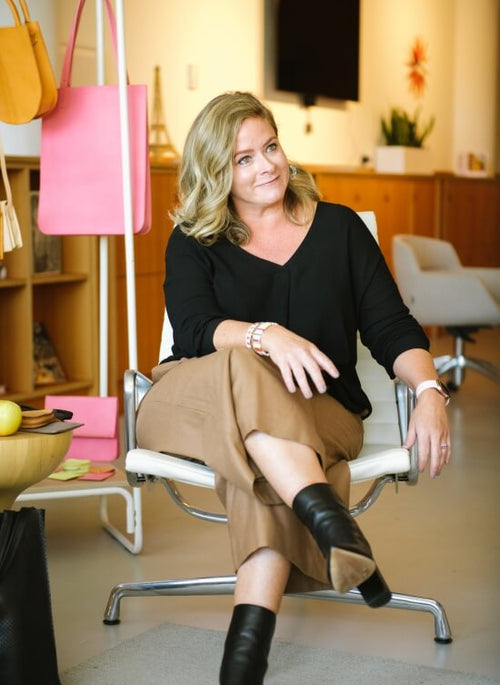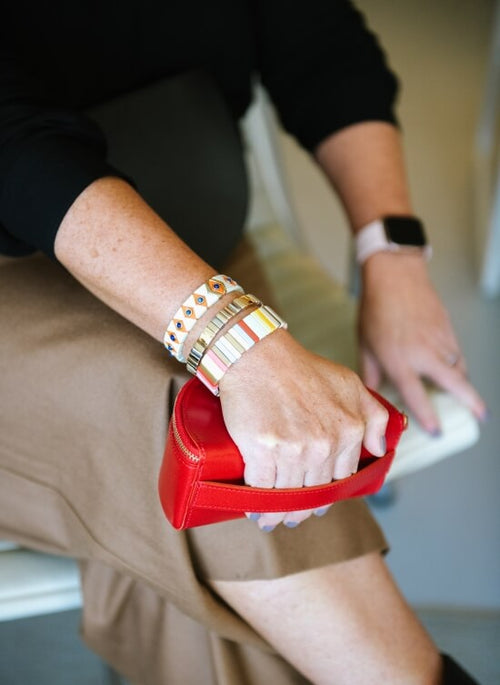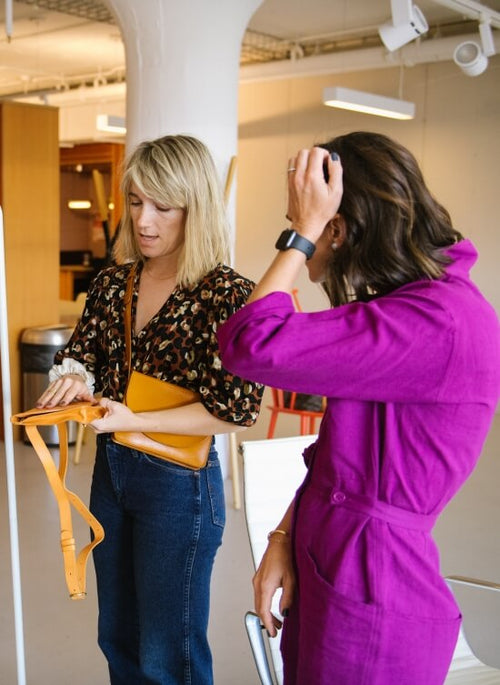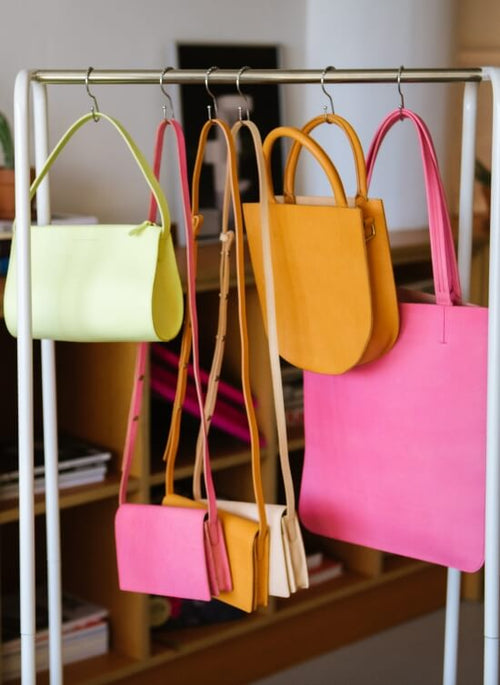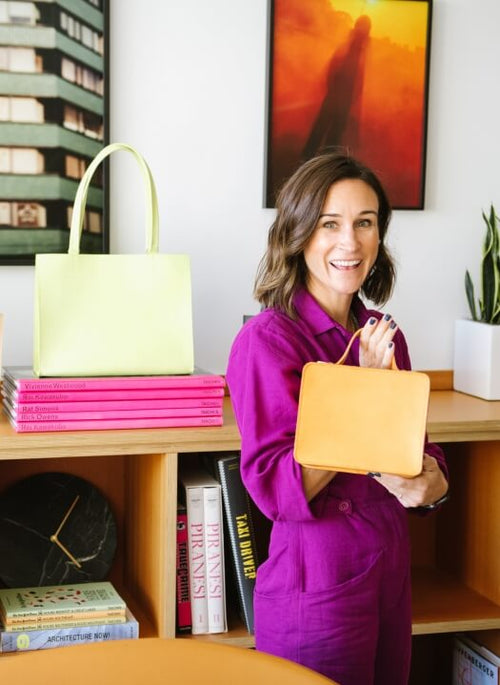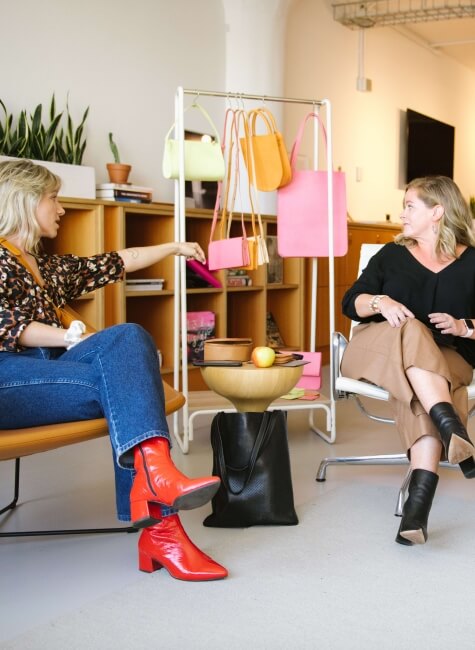Your cart is empty.
Let’s find your perfect shade.
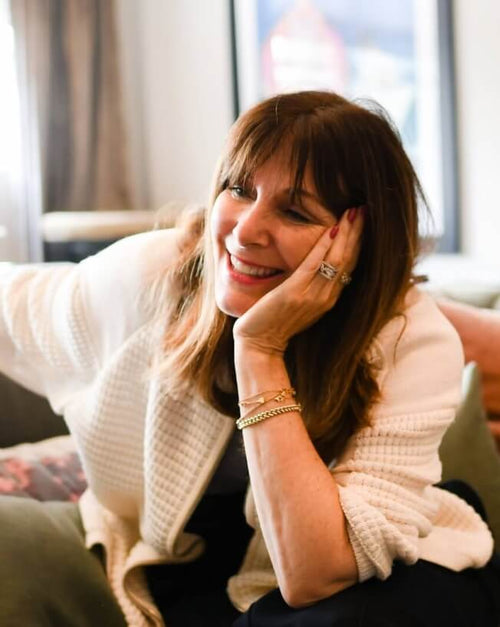
Cart (0)
Your cart is empty.
Let’s find your perfect shade.
Minor Historyis a thoughtfully designed range of classic leather accessories made more sustainable through the process of vegetable-tanning. Whereas most ‘fast fashion’ leather accessories are chrome-tanned and lined with synthetics, Minor History has gone back to the basics to honor natural materials. The result has been a super successful collection of staple everyday accessories in modern, wearable shapes that are equally flattering as they are functional.We recently visited the team behind Minor History—Hillary and Dave Ortiz, Alice Blair, and Topher O’Rourke—to discuss their design process and lessons learned in sustainable accessory design.
MELISSA: Can you tell us about how you started and the backstory?
DAVE: Topher and I have been working together for over 10 years…actually more than that—15 years. We’ve been manufacturing product for gifts and designer brands, so we’ve been making everything from barware to stationary items—you name it. But we always wanted to start our own brand. We’re always looking for an opportunity to add value.
I bought a designer bag for my wife 6 or 7 years ago and we were taking a look at it and….
HILLARY: Dave grabbed the bag and studied every stitch. He was like “the stitching is off; this could have been better.” He’s looking at the liner like “this is a waste” and I’m like, “Can I just enjoy my bag?”
DAVE: Our process is that. We ask our customers, whether it’s a flask or a notebook or whatever it is, we say “this is a sample, but we’ll dissect it and we’ll find a factory that will elevate it or add aesthetic design or a little bit of colour.” I’m always looking at product and Topher and I are dissecting this bag and it’s a nice quality leather but there are patches of faux leather where there doesn’t need to be. So, our partner in Asia told us, they’re doing this to save money, to lower costs. There’s also a liner in there, and we’re like, “do they need a liner?” and he says, “that’s to cover the poor workmanship, even though it looks pretty.”
TOPHER: If the bag is lined, the inside of the leather is irrelevant. So right there, the leather cost can be lower, and it can be a lot thinner because you can add pieces of structure.
So, we asked ourselves, how can we make bags that have this appealing look, but don’t need any of those tricks? And then offer the product at a price point that’s reasonable and build a business on that; let that tell the story.
Sustainability also plays a part—we don’t use plastic, polyester liners or fillers. 90% of the world’s leather is chrome-tanned which is horrible for the environment, but we’re using only vegetable tanned leathers, which is the cleanest way to do leathers. So, we’re building new silhouettes that appeal to people and have functionality but are still on-trend and current—and expanding the line that way. But really, the emphasis was on ‘how do we make a better bag?’ Because it clearly can be done better.
MELISSA: Tell us about the design process? How did you start?
DAVE: This is where Alice comes into the story. Alice was at a design group that was working with one of our clients. We had an existing relationship with her, so we said “guys, we can do this so much better; here’s a raw concept,” and we handed it off to them and that’s where they really took it to the next level in terms of designing the colour lace, the shapes and really making it a timeless piece. And that’s the key—a lot of the stuff we see today is throw-away stuff. Because more sustainable stuff wasn’t in—this was like 5 years ago. So, from there, we started working with their group and spent about a year developing the line.
ALICE: They were really flexible. They were carte blanche like, “if you were going to make a bag, what would you make?” That’s something that’s not usually asked. Usually there’s some ego involved, but it was really open which was really cool. We all had the experience of buying a bag and having something fall off after a year. Or just not identifying with anything on the market. For example, super minimal shapes with really good leather were not available at this price point. They had started to come around at 7 or $800, but that was a totally different market from the one we were in. So, this was a dream project. It was a really cool exercise.
MELISSA: What was the first bag you launched with?
ALICE: Some of them are still here. The Plie tote, radio—that oval cross-body, the long black tote. I think we were thinking about functionality and you need more than a bag. You also need the right wallet and the right sunglasses. It wasn’t just about a fashion statement.
TOPHER: Also, with production we wanted to use as much of the leather as possible. If there are small pieces…that’s why lots of brands have small accessories. We have quite a few small things because we’re not going to throw them away. We use only two materials: vegetable-tanned, full grain leather and solid brass hardware. Our threads are OEKO-TEX certified.
HILLARY: That’s another point about leather. If you use really thin, lower quality leather, you have to line the bags and the usable surface is tiny, so when broken, one part is cut out and the rest is tossed or burned, which is super troubling. Using the right materials, you can create a more sustainable product.
MELISSA: Was ethical sourcing always an important part of the brand, or did it just happen as you went along?
HILLARY: We always were interested in vegetable tanned leathers, but it was something we doubled down on and recommitted to in the last couple years as this became a really urgent conversation. We love our factory because they’re creating quality over quantity, and that impacts how the workers are treated and the environment. They’re audited in the right way. We’re never going to use plastic—we knew that from the beginning. Plated hardware also ends up being disposable because of chips and breaks. Getting the right color with vegetable tanned leathers is tricky, it’s always a challenge, but it’s something we returned to and we said ‘we need to just figure this out. We can do it. It’s going to be more work, but it’s worth it.’
TOPHER: It’s really interesting how the structured nature of the vegetable tanned leather has played a part in where the collection is going. The collection is becoming more dimensional each season because we’re committing to more structured leathers that don’t rely on plastic fillers to create that sort of shape. There’s this really cool interplay of choosing the right materials and using them in a way that makes sense for the end product.
MELISSA: Because your designs are so simple in that they don’t have a lot of bells and whistles, was there a particular person you had in mind when creating your bags?
HILLARY: We love Emma Stone because she emulates that beautiful natural style and her intelligent personality. And when we started our original mood board, we weren’t really looking at fashion reference, but architecture and art and strong personalities. So, we had this great image of Sean Young from the old Bladerunner and she’s so cool. It wasn’t about what she’s wearing, but it was about her attitude. We always thought about the person wearing the bag and wanted their personality to shine through. We want it to feel like their bag—not like they’re wearing our bag.
Also, we always test out our smaller/medium sized bags (like our crossbodies) with an ‘apple test.’ Alice will always bring an apple for new product meetings and if the sample doesn’t fit her apple, it doesn’t make the cut!
MELISSA: Where did the name come from? Obviously, it’s very discretely printed on the bags. Was it intentional to be so discrete?
ALICE: It was a huge conversation and we were unanimous about it. We were all bothered by huge logos front and center. Again, it’s about focusing on the person and not allowing the bag to steal all the attention.
Minor History to me is about…we always thought about our ideal customer as having an interest in art and architecture and being really savvy about that. Maybe she never had that personal history, her love for those things be expressed in the things she buys. So, this line will resonate with her. It comes full circle. For example, her travels, and what inspires her.
MELISSA: You already mentioned that all the smaller pieces of material are used for your card cases and things like that, but I noticed your jewelry case. I’m a big jewelry lover and to find a good jewelry case is very difficult. Was this always part of your repertoire?
ALICE: So much of our small stuff relates to travel. For example, we have luggage tags and a passport case, so we were sort of completing that story and how to make it better and more beautiful. Jewelry pieces are hard to find, or they’re not meant to be seen.
DAVE: I always imagined that maybe the customer is going to her friend’s wedding and it’s just what she needs for that weekend away. It’s definitely for those moments of travel or special events.
MELISSA: Where did the idea for the perforated leather come from? It’s a little sporty and different.
ALICE: Yeah, that was an early idea. We have capabilities to customize…sky is the limit. We were interested in textures, but we didn’t want to add anything because there’s always the risk of it chipping off over time. So, we thought, instead, what can we take away?
MELISSA: What are the items that each of you never leave your house without? What are your daily particulars?
HILLARY: I’ve got this Apple watch.
ALICE: My phone. My water bottle. It’s not cute at all, but it’s functional.
TOPHER: My sunglasses…I carry my prescription Ray-Bans everywhere I go. I carry them in my Minor History eyeglass sleeve and it’s always in my pocket because I can’t see.
DAVE: I just make sure I’m fully dressed. If I get out the door with clothes, it’s a successful morning.
MELISSA: What are your favorite pieces from the collection that you use every day?
HILLARY: Wallet and belt bags. I use the earbud case.
DAVE: I am so minimal. I use the Oyster Wallets.
MELISSA: What’s next for you guys? Do you have any collaborations in the works?
HILLARY: Always pushing the boundaries. We’re working with influencers and really diving into the space of sustainability.
MELISSA: Has Emma Stone wore the bags yet?
HILLARY: We’re working on it!
